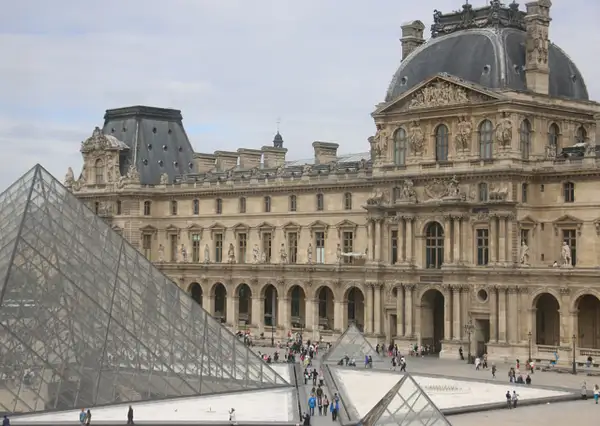


Venus de Milo, Greece, 130 BC
Aphrodite of Milos better known as the Venus de Milo, is an ancient Greek statue and one of the most famous works of ancient Greek sculpture. Created sometime between 130 and 100 BC, it is believed to depict Aphrodite, the Greek goddess of love and beauty (Venus to the Romans). It is a marble sculpture, slightly larger than life size at 203 cm (6 ft 8 in) high. The arms and original plinth were lost following its discovery. From an inscription that was on its plinth, it is thought to be the work of Alexandros of Antioch; earlier, it was mistakenly attributed to the master sculptor Praxiteles. It is currently on permanent display at the Louvre Museum in Paris. The statue is named after the Greek island of Milos, where it was discovered
|
Georgia and her friend Venus |
Venus de Milo, Greece, 130 BC |
Venus de Milo disarms an admiring crowd |
The Louvre |
Winged Victory of Samothrace-Greek, circa 200 BC
The Winged Victory of Samothrace, also called the Nike of Samothrace, is a 2nd-century BC marble sculpture of the Greek goddess Nike (Victory). Since 1884, it has been prominently displayed at the Louvre and is one of the most celebrated sculptures in the world. H.W. Janson described it as "the greatest masterpiece of Hellenistic sculpture."
|
Tom in the Louvre |
I.M. Pei's Pyramid and the Richelieu Wing, The Louvre |
Ceiling detail-The Louvre |
Ceiling detail-The Louvre |
Selfie Sticks were ubiquitous in the Louvre |
The Mona Lisa-much smaller than you'd imagine
The Mona Lisa is a half-length portrait of a woman by the Italian artist Leonardo da Vinci, which has been acclaimed as "the best known, the most visited, the most written about, the most sung about, the most parodied work of art in the world". The painting, thought to be a portrait of Lisa Gherardini, the wife of Francesco del Giocondo, is in oil on a white Lombardy poplar panel, and is believed to have been painted between 1503 and 1506. Leonardo may have continued working on it as late as 1517. It was acquired by King Francis I of France and is now the property of the French Republic, on permanent display at the Louvre Museum in Paris since 1797.The subject's expression, which is frequently described as enigmatic, the monumentality of the composition, the subtle modeling of forms, and the atmospheric illusionism were novel qualities that have contributed to the continuing fascination.
|
The largest painting in the Louvre's collection-The Wedding at Cana by Paolo Veronese (1563)
The Wedding at Cana is a massive oil painting by the late-Renaissance or Mannerist Italian painter Paolo Veronese. It is on display in the Musée du Louvre in Paris, where it is the largest painting in that museum's collection.The piece was commissioned in 1562 by the Benedictine Monastery of San Giorgio Maggiore in Venice, Italy, and completed in fifteen months by the year 1563. It hung in the refectory of the monastery for 235 years, until it was plundered by Napoléon in 1797 and shipped to Paris. The painting was cut in half for the journey and stitched back together in Paris. It was not returned in the post-Napoléonic conciliation treaties which pursued some restitution of looted artworks. The painting was taken to Brest and stored in a box during the Franco-Prussian War and rolled up and moved around France in a truck during World War II.
|
The Louvre's expansive interior |
The Coronation of Napoleon by Jacques-Louis David (1807)
The Coronation of Napoleon is a painting completed in 1807 by Jacques-Louis David, the official painter of Napoleon. The painting has imposing dimensions, as it is almost 10 metres (33 ft) wide by a little over 6 metres (20 ft) tall. The crowning and the coronation took place at Notre-Dame de Paris.
|